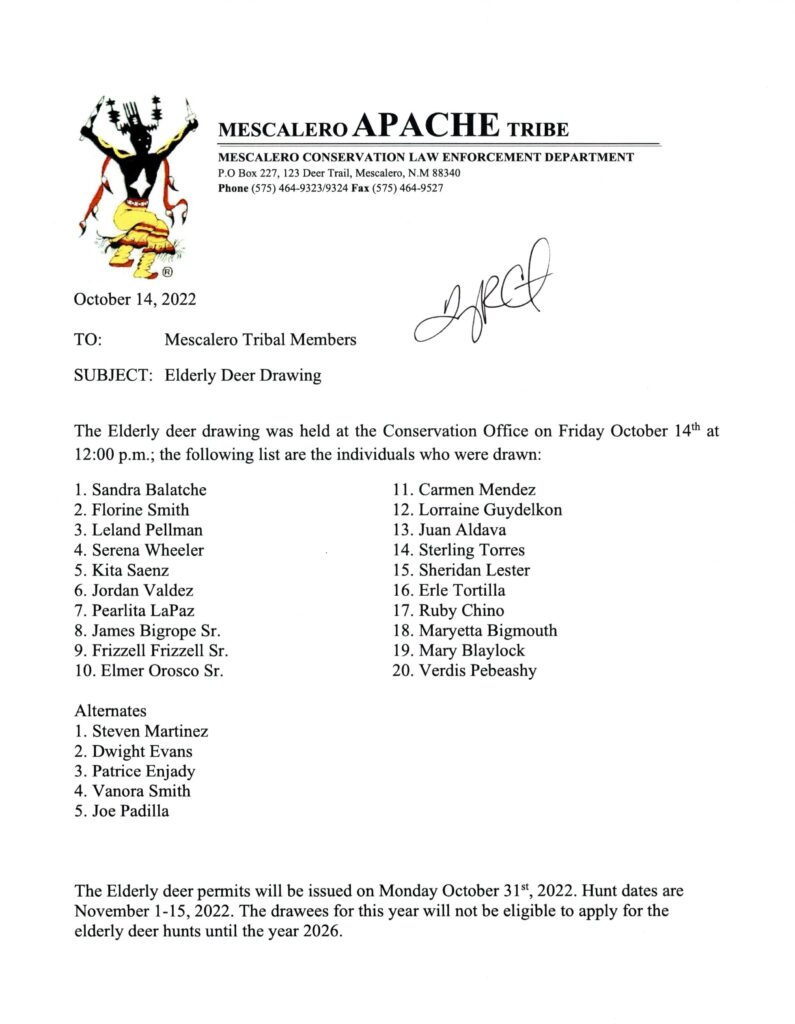
2022 Deer Hunt draw results
Presentation on autism & the Native community: Oct. 19th
Mescalero Apache Tribe COVID-19 Test Results
Halloween Haunted Hall: Oct. 31st
Car Seat Clinic: Oct. 15th
Public Service Loan Forgiveness Program
The Public Service Loan Forgiveness Program (PSLF) forgives the remaining balance on your Direct Loans after you have made 120 qualifying monthly payments under a qualifying repayment plan while working full-time for a qualifying employer. If you are employed by a U.S. federal, state, local, or tribal government or not-for-profit organization, you might be eligible for the PSLF.
The Biden Administration has made temporary changes to the program that may allow tribal government (and other government) and non-profit employees who were not previously eligible, to be eligible or receive additional credits towards repayment. This is called the Limited PSLF Waiver. The deadline to apply for this limited program is OCTOBER 31ST. After October 31st, normal PSLF rules will apply.
Learn more about the temporary changes at www.studentaid.gov/pslfwaiver.
FREE Furniture
2022 NM Missing Persons Day: Oct. 22nd
Save the date!
In support of ALL New Mexicans who are searching for missing relatives, the NM Department of Public Safety (“NMDPS”) in conjunction with the NM Missing and Murdered Indigenous Women and Relatives Task Force (“Task Force”) and the NM Indian Affairs Department (“NMIAD”), will host a Missing Persons in New Mexico Event which will provide families with the opportunity to:
- file or update missing persons reports,
- submit DNA records,
- meet with investigators and
- access support services.
Saturday, October 22, 2022, from 9am – 3pm at the Indian Pueblo Cultural Center 2401 12th Street NW, Albuquerque, NM 87104
FOR MORE INFORMATION OR TO REGISTER, PLEASE VISIT https://www.iad.state.nm.us/missinginnewmexicoday/
OR CONTACT:
DPS.MissingPerson@State.nm.us
Ashlyn Wagoner
(505)901-7396

ENMU-Ruidoso Recognizes Nursing Students at Pinning Ceremony

Ruidoso, NM
ENMU-Ruidoso Branch Community College recognized 10 nursing assistant students Friday, Oct. 7. The students were pinned and presented with nursing assistant certificates (CNA) of occupational training.
At the ceremony Director of Career and Technical Education John Rucker welcomed the audience with opening remarks. Larry Lewis of the Mescalero Care Center was the guest speaker. CNA Instructor JoAnn Wolfe recognized the nursing students, and the class was presented for pinning. Pinning a graduating nursing assistant student symbolizes their initiation into the nursing profession and marks the completion of the CNA training.
The graduates and their hometowns include; Alamogordo: Kylea Walker, Jessica Pino; Alto: Billy Casey Meeks; Capitan: Jasmine Kennedy; Mescalero: Tyler Hiles, Caydence Palmer; Ruidoso: Katlynn McSwane; Ruidoso Downs: Hannah Hulett, Carlos Nava, Allie Ordorica.
The certificate of occupational training in nurse assistant is designed to prepare students to successfully sit for the state nurse assistant certification examination. This program is designed to educate students in physical, emotional, and spiritual assessment of residents’ needs and concerns. Students receive training and practice in all state required resident care skills in the classroom lab as well as in several community settings. Students learn resident rights as well as the laws that protect those rights. Understanding of the role of the nurse assistant within the legal scope of practice is an expected outcome of this program.
ENMU-Ruidoso also offers a 34-credit hour pre-nursing certificate which provides students with coursework identified by the New Mexico Nursing Education Consortium (NMNEC) as the common statewide prerequisites and general education courses for a bachelor’s degree in nursing (BSN). Students who complete this certificate can transfer to any state funded NMNEC New Mexico Community College or University and apply for admission into their associate degree nursing (ADN) program.
To learn more about ENMU-Ruidoso’s nursing programs, visit https://ruidoso.enmu.edu/academics/associate/pre-nursing-student-nurse-assistant/, or call 575-315-1120.
- « Previous Page
- 1
- …
- 78
- 79
- 80
- 81
- 82
- …
- 147
- Next Page »






